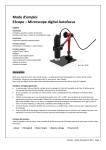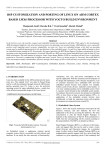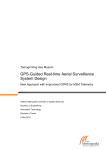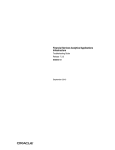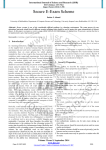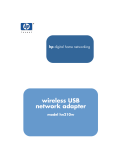Download Multi-Powered GSM based SMART Surveillance System
Transcript
International Journal of Combined Research & Development (IJCRD)
eISSN:2321-225X;pISSN:2321-2241 Volume: 4; Issue: 4; April -2015
Multi-Powered GSM based SMART Surveillance System
S Akash
Senthamizh Selvi S
Dept of Electronics and Communication,
C Byregowda Institute of Technology, Kolar
Dept of Electronics and Communication,
C Byregowda Institute of Technology, Kolar
Swathi R
Vinaya V Tamashetti
Dept of Electronics and Communication,
C Byregowda Institute of Technology, Kolar
Dept of Electronics and Communication,
C Byregowda Institute of Technology, Kolar
Ms. Shwetha R,
Assistant Professor,
Dept. of ECE,
C Byregowda Institute of Technology, Kolar. India
ABSTRACT: In this paper, we implement a system that monitors an
Different power sources are solar, wind, battery and main supply.
We make use of PIR sensors to detect the human intrusion.
Provides alert to the user during a threat.
Live video streaming of the authorized area is done once there is
intrusion.
User can take the decision of providing alert by sending a SMS to
activate or deactivate buzzer.
Also stores the snap shots of that area for every 5 secs in
.JPEG format.
authorized area that makes use of live video streaming technology only
at the time any intrusion thus, eliminating huge hard disk requirement.
The system is built using Raspberry PI, Arduino, GSM modem, an IR
Camera, and also PIR sensors. To make it smarter we make use of
multiple power sources to provide power for the entire system working.
It immediately gives alert to the user during a threat. To make it still
smarter we have made the system to store the .jpeg format for each
5secs from the start time of video capturing.
Keywords: Raspberry-PI, Surveillance system, Arduino, Live video
streaming, Smart security.
1.
INTRODUCTION
3.
BLOCK DIAGRAM
:
Surveillance is used by governments for intelligence gathering,
the prevention of crime, the protection of a process, person, group or
object, or for the investigation of crime. It is also used by criminal
Surveillance is the monitoring of the behavior, activities, or other
changing information, usually of people for the purpose of influencing,
managing, directing, or protecting them. This can include observation
from a distance by means of electronic equipment (such as CCTV
cameras), or interception of electronically transmitted information (such
as Internet traffic or phone calls); and it can include simple, relatively
no- or low-technology methods such as human intelligence agents and
postal interception. The word surveillance comes from a French
phrase for "watching over" ("sur" means "from above" and "veiller"
means "to watch"), and is in contrast to more recent developments such
as surveillance. organizations to plan and commit crimes such as
robbery and kidnapping, by businesses to gather intelligence, and by
private investigators. In order to overcome the disadvantages of the
already existing CCTV systems that makes use of huge hardware
resources in order record video and store it safe without any use. So to
overcome this we implement our system which does not make use of
any external hardware for storage and also provides highly effective
alert during any intrusion.To build this kind of a smart surveillance
system we make use of Raspberry-PI processor, Arduino
(microcontroller board), PIR sensors, GSM module (SIM900), LCD
display and other building blocks.
2.
SPECIAL CHARACTERISTICS
System is multi-powered, to provide effective security form the
intelligent thieves.
www.ijcrd.com
Page 580
International Journal of Combined Research & Development (IJCRD)
225X;pISSN:2321-2241 Volume: 4; Issue: 4; April -2015
Fig :1 - Block diagram of the entire system
Arduino is the heart of the system. It controls the entire function of
the system. PIR sensors, GSM modem, power controls and RaspberryPI are connected to Arduino. LCD display is connected in order to
display various information like power levels and the source with which
it is working. Camera is mounted on stepper motor and connected with
Raspberry-PI through a motor driver.
The block diagram of the entire system is as shown in fig, it
consists of Arduino, Raspberry-PI, GSM modem, and other hardwar
that instant. for example, intruder detected, sms sent, calling, battery
voltages, and buzzer on, buzzer off.
After providing the alert the system waits for a alert to activate the
buzzer or to be reset, on encountering any of these two conditions it
stops the live video streaming.
5.
4.
DESIGN IMPLEMENTATION
Most of the security systems make use of a light bulb with light
dependent resistor (LDR) Infrared LED or ordinary phototransistor as
the sensor. These security systems work satisfactorily in darkness and
cannot be used outdoors because of the chances of false triggering due
to light sensed from other light sources like tube lights , CFL lamps ,
Sun light, etc., These systems are often offline , consume lot of power
and use Hard disk as a video storage medium, and does not inform
about any intrusion.
In this project, the complete system is activated by sending a code
through SMS by authorized person. Once the system is activated the
PIR sensor is active, whenever there is a human intrusion it detects and
immediately gives an alert to authorized person by making a call and
sending an SMS. Simultaneously, the Raspberry-PI is triggered such
that the camera starts capturing the video of that area and uploads it
online. Such that the authorized person at the other end could monitor
that particular scene from his place and he can also rotate the camera
o
through the front face provided to almost 270 thus enabling faster
solution. On missing this we are also storing the snaps of that area for
every 5secs in .JPEG format. The user may then take the necessary
action so as to activate the buzzer or any other solution.
This system is multi powered that it is provided with four different
power sources such as solar, wind, battery and AC supply. The priority
is first given to solar first then to wind then battery and finally to AC
supply. Using an auto change over system the power source is selected
and the system works on it. The system also gives an alert to the user
when there is no power source to work.
A LCD display is used in order to display the present working
condition of system. It is also used to display the various power levels
of different power sources and displays on which power it is working at
temperature pattern. Thermal signals far below one microwatt are
sufficient to trigger a sufficient output voltage change.
GSM SIM900: the sim900 is a complete quad-band GSM/GPRS solution
in a SMT module which can be embedded in the customer applications.
Featuring an industry-standard interface, the sim900 delivers GSM/GPRS
850/900/1800/1900mhz performance for voice, SMS, data, and fax in a
small form factor and with low power consumption. With a tiny
configuration of 24mm x 24mm x 3mm, sim900 can fit almost all the space
www.ijcrd.com
eISSN:2321-
HARDWARE AND SOFTWARE TOOLS
REQUIRED
5.1. HARDWARE:
Raspberry-PI: the raspberry-pi is a credit-card-sized single-board
computer developed in the UK by the raspberry pi foundation with the
intention of promoting the teaching of basic computer science in
schools. it is manufactured in two board configurations through
licensed manufacturing deals with network
element14 (premier
farnell), RS components and ego man. these companies sell the
Raspberry PI online. ego man produces a version for distribution solely
in china and Taiwan, which can be distinguished from other pi’s by
their red colouring and lack of FOC/CE marks. the hardware is the
sameacrossallmanufacturers.
the
raspberry pi
has
a Broadcom BCM2835 system on a
chip (soc), which includes
an arm1176jzf-s 700 MHZ processor, video core iv GPU and was
originally shipped with 256 megabytes of ram, later upgraded to
512 MB. It does not include a built-in hard disk or solid-state drive,
but uses an SD card for booting and persistent storage.
Arduino 2560: the Arduino mega 2560 is a microcontroller board
based on the atmega2560 (datasheet). it has 54 digital input/output pins
(of which 15 can be used as PWM outputs), 16 analog inputs, 4 UARTs
(hardware serial ports), a 16 MHZ crystal oscillator, a USB connection,
a power jack, an ICSP header, and a reset button. it contains everything
needed to support the microcontroller; simply connect it to a computer
with a USB cable or power it with an ac-to-dc adapter or battery to get
started. The mega is compatible with most shields designed for the
Arduino duemilanove or diecimila. The mega 2560 is an update to the
Arduino mega, which it replaces.
PIR sensor: Pyro-electric passive infrared sensor (PIR) is designed to
pick up heat radiation of wave lengths in a band around 10 microns. It
contains two active elements configured as balanced differential series
opposed type. this results in good compensation of environmental
temperature and excellent sensitivity for small changes of a spatial
requirements in your m2m application,
especially for slim and compact demand of
design. ”sim900 is designed with a very
powerful single-chip processor integrating
amr926ej-s core”. quad - band GSM/GPRS
module with a size of
24mmx24mmx3mm ”SMT type suit
for
customer
application
”an
embedded powerful TCP/IP protocol
stack ”based upon mature and field-
Page 581
International Journal of Combined Research & Development (IJCRD)
eISSN:2321-225X;pISSN:2321-2241 Volume: 4; Issue: 4; April -2015
proven platform, backed up by our support service, from
definition to design and production.
LCD display: A liquid-crystal display (LCD) is a flat panel display,
Makes a alert call of 15secs and then sends
an SMS to registered users
electronic visual display, or video display that uses the light
modulating properties of liquid crystals. Liquid crystals do not emit
light directly. LCDs are available to display arbitrary images (as in a
general-purpose computer display) or fixed images which can be
displayed or hidden, such as preset words, digits, and 7-segment
displays as in a digital clock. They use the same basic technology,
except that arbitrary images are made up of a large number of small
pixels, while other displays have larger elements.
Waits for the buzzer
activation or system
deactivation code
through SMS
Solar panel: Solar panel refers either to a photovoltaic module, a
solar hot water panel, or to a set of solar photovoltaic (PV) modules
electrically connected and mounted on a supporting structure. A PV
module is a packaged, connected assembly of solar cells. Solar panels
can be used as a component of a larger photovoltaic system to generate
and supply electricity in commercial and residential applications. Each
module is rated by its DC output power under standard test conditions
(STC), and typically ranges from 100 to 320 watts. The efficiency of a
module determines the area of a module given the same rated output –
an 8% efficient 230 watt module will have twice the area of a 16%
efficient 230 watt module. There are a few solar panels available that
are exceeding 19% efficiency. A single solar module can produce only
a limited amount of power; most installations contain multiple modules.
A photovoltaic system typically includes a panel or an array of solar
modules, an inverter, and sometimes a battery and/or solar tracker and
interconnection wiring. If we can harness the solar power efficiently,
then we may not need to rely on burning fossil fuels for energy.
5.2. SOFTWARE:
Raspbian- OS for Raspberry-PI Sketch- Programming language for
Arduino.
6.
FLOWCHARTS
OPERATION
REPRESENTING
Activates buzzer or
resets the entire
system
Fig 2 : Flow diagram of Arduino task 1
PIR detects the
human intrusion
Arduino triggers the
Raspberry-PI, hence
activating the camera
SYSTEM
PIR detects the human
intrusion
Streams the video online,
enabling user to view by
rotating the camera from
his end.
Arduino triggers the GSM MODEM
Simultaneously captures
images of that area and stores
it in .JPEG format for each
5secs
Resumes to default
condition when the
system is reset
Fig 3 : Flow diagram of Arduino task
www.ijcrd.com
Page 581
International Journal of Combined Research & Development (IJCRD)
eISSN:2321-225X;pISSN:2321-2241 Volume: 4; Issue: 4; April -2015
7.
ADVANTAGES, DISADVANTAGES AND
APPLICATIONS
7.1. ADVANTAGES
System is relatively cheap
It uses multi-power supply
System consumes low power.
Highly secured compared to present system.
No hard disk required.
The entire setup is automated.
7.2. DISADVANTAGES
Continuously uses the internet facility.
Performance depends on mobile signal strength.
7.3. APPLICATIONS
Military facilities, restaurants, banks, schools, colleges.
Used in home security.
[4] Chen Rongfang, Wang Haibin, Hu Zhenhua, Zheng Pin. Remote
Monitor System of Power Network Based on Embedded Internet
Technology. Microcomputer Information. vol. 24, no. 7-2, pp. 78-80,
2008 S3C6410 Microcontroller User's Manual Revision1
http://www.samsungsemi.com.
[5] Hang Zhou, David Suter,"A compact architecture for wireless video
surveillance over CDMA network [A]," In: Proceedings of IEEE
International Conference on Video and Signal Based Surveillance,2006
[C] Sydney, Australia, 2006, II,pp.102-107.
[6] Xie Hong-hua,Lu Yi-qin,Lv Jin,"The designing of High-quality
real-time
video
surveillance
system
based
on
3G
wirelessnetwork[J],"ComputerApplications,2007,24(lO),pp.313-317.
[7] X. Cai, F. Ali, and E. Stipidis, "Mpeg4 over local area mobile
surveillance system," lEE Colloq. (Dig.), vo!. 3-10062, pp. 81- 83,
2003.
Used in theft detection and surveillance units.
8.
RESULT AND CONCLUSION
Implementation of this project is done successfully we are able to
implement this in a 30 feet area with two PIR sensors, when an intruder
is sensed it successfully alerts the user and streams the video online.
This can be enhanced in future the storage can be built using cloud
computing.
9.
ACKNOWLEDGEMENT
We would like to thank our principal Dr. Suresh K R for providing
us facilities to implement this project in college premises, Dr. G M
Sreerama Reddy, HOD, ECE dept for providing moral support and our
guide Ms. Shwetha R, Asst Professor, ECE dept for providing excellent
guidance for carrying out entire work.
10. REFRENCES
[1] International Journal of Electronics And Communication And
Computer Engineering Volume 5, Issue(4) July, Technovision-2014,
ISSN 2249-071x “Next Generation SMART Supervisor Using ARM
11” Published By IJECCE.
[2] International Jounal Of Engineering And Technology (IJET)
“Enhancing Building Security With RFID And Zigbee” Vol 5 No 1 Feb
2013 ISSN:0975-4024.
[3] 2014 International Conference on a reliability optimization and
Information Technology- ICROTT, India,Feb 6-8 2014 “Raspberry Pi
www.ijcrd.com
Page 582
International Journal of Combined
Research & Development (IJCRD)
eISSN:2321-225X;pISSN:2321-2241
Volume: 4; Issue: 4; April -2015
Based Interactive Home Automation System through Email”
www.ijcrd.com
Page 481






